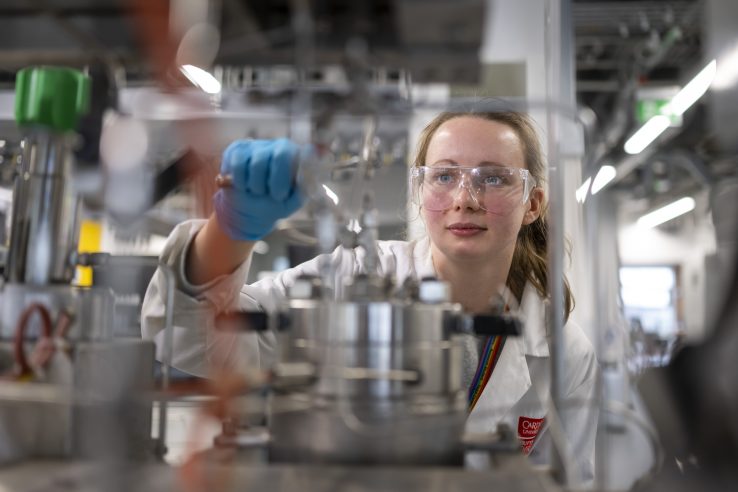Catalysis for a better world
6 September 2023
The UK’s newest centre for Net Zero solutions brings industry and scientists together to solve complex global challenges. Resarchers in the Institute for Compound Semiconductors (ICS) and Cardiff Catalysis Institute (CCI) use state-of-the-art Translational Research Hub (TRH) facilities to collaborate with commercial partners. At a recent TRH launch event, six TRH researchers outlined their work. In the first of a series of blogs, we hear excerpts from two of their speeches…
Dr Jennifer Edwards, Senior Lecturer in Physical Chemistry, Heterogeneous Catalysis section of CCI
“The type of catalysts we are interested in making take powder form. They tend to be decorated with very small amounts of precious metals or non-precious metals, so gold, palladium, platinum, nickel, and silver.

The role of a catalyst is to speed up a chemical reaction that would already happen. A catalyst does so in such a way that a much lower energy input is required, so you can work on chemistry at lower temperatures and pressures.
That becomes very important when you consider the stability of molecules like carbon dioxide that are very difficult to activate chemically. In the presence of a catalyst, you can do this relatively easily, converting it into useful molecules.
Our work with catalysts includes sustainable alternatives to commodity and industrial chemicals, and this can enable small-scale local synthesis of those chemicals at the point at which they are required, mitigating the need to transport chemicals.
Another aspect we are looking at is taking carbon which nature is fixing for us – sustainable biomass – and using that carbon and that resource to make chemicals and fuels that you would normally get from fossil resources.
We also work on photo-catalysis. A photo-catalyst is something that can absorb sunlight and transfer that energy to any surrounding molecule, and this is a very good utilisation of what is an unlimited energy resource, but if those surrounding molecules are oxygen or water, you can create reactive oxygen species of free radicals, and those free radical species are highly oxidized, and very potent in terms of chemical remediation or biological remediation.
We have translational applications for these. My colleague, Mike, will now talk about his work around microbiological remediation.”
Dr Michael Pascoe, Researcher, Cardiff Catalysis Institute
“One in eight women and girls around the world are unable to access the products they need to safely manage their periods. Many turn to washable products because they are more affordable than single-use items like pads and tampons.

In many rural communities, however, they lack access to water, soap and disinfectants needed to make these products safe, so the products can become very heavily contaminated with bacteria and fungi, which poses an infection risk. In fact, urinatory tract infections (UTIs) and reproductive tract infections (RTIs) can lead to missing time in school or work, and it’s a leading cause of neonatal and maternal morbidity in the developing world.
So, our research concerns the development of self-cleaning and self-disinfecting textiles. These textiles contain photo-catalysts that can generate free radicals from water and air. These free radicals are extremely reactive and can destroy bacteria, break down stains and malodours.
Using the principles of photo-catalysis, we have developed textiles which are able to kill 99.99 per cent of bacteria after being left in the sun to dry for just two hours. We are planning to incorporate these textiles into reusable menstrual products like pads and period underwear, and because they are catalysts, only minute quantities are needed, which keeps costs low. Moreover, they maintain their effectiveness over many cycles of use, so it’s a truly circular product.
We are now in the process of validating our technology with partners based in Nepal, where menstrual stigma has a major impact on the lives of women and girls. In fact, up to half of female agricultural workers in rural Nepal have a UTI or RTI at any one time, and this continues to exacerbate health, social and economic inequalities.
Over the next year, we will be analysing samples of used products to find out their microbial signature – in other words, which microbes are present, and how much is there. This will help us to validate our lab models to ensure that the things we are doing in the lab are reflecting real world use.
This project will pave the way for human trials in 2024, while we will be assessing the effectiveness of our products to prevent UTIs. By working with NGOs in Nepal., our vision is to create a cleaner, greener and safer future for female menstrual health.”
For more information, visit the Net Zero Innovation Institute website or email NZII@cardiff.ac.uk
To find out more about the work of the TRH, click here or watch our film 👇👇👇 .